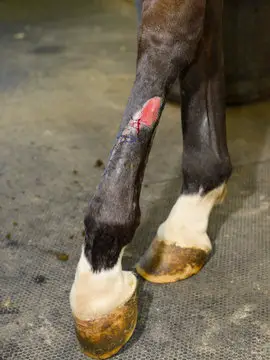Last Updated on February 21, 2022 by Allison Price
Your gelding arrives with a cut on the pastern. The cut doesn’t seem too serious so you clean it up and apply some antibiotic cream. The cut isn’t too deep and has stopped bleeding. You decide to not call the vet. The cut is not open anymore after two weeks, but it still hasn’t healed. Instead, a layer reddish-colored, lumpy tissue covers the wound. The veterinarian informs you that you are seeing proud flesh or an excess of granulation tissue.
Most often, proud flesh is caused by an injury to the lower leg of the horse. Below the horse’s knees or hocks there is very little soft tissue. The skin is tightly pulled over the bones and tendon. The skin near joints like the pastern moves with every step. This slows down healing and makes it more difficult to heal.

Because the skin that covers the muscles and is less tensioned means that the horse’s movements are not as forceful on the edges of wounds, injuries to other parts of the horse’s body will develop proud flesh less frequently. These areas can be sutured to prevent the growth of pride flesh. To speed healing and minimize scarring, it is important to suture wounds as soon as they occur. Because the skin is tightly wrapped, it is more difficult to sew wounds on the lower legs.
Normal wound healing involves the formation of granulation tissue, which is followed by skin growth over the granulation tissue, starting at the edges and moving toward the center. If suturing is not possible in an area, excessive granulation tissue may form. This happens when skin formation is interrupted by tension or movement.
A veterinarian might use bandaging or a cast in order to give the leg wounds the best chance for healing. This allows the skin to grow faster than normal granulation tissue. It also reduces or prevents the appearance of proud flesh. It should be removed from wounds if it occurs. If the proud flesh has grown too large, it may need to be removed in smaller stages. It is important to treat proud flesh early in its development. Because granulation tissue does not have nerves, trimming can cause a lot of bleeding. However, it may not be too painful for the horse. The nerves of the healthy tissue under and around the proud flesh do exist, but the horse may have to be sedated.
After the excess granulation tissue has been removed, the wound is closed with a bandage to stop bleeding. The wound is then allowed to heal. A steroid ointment may be prescribed by the veterinarian to prevent the growth of proud flesh and not affect the formation of new skin. To speed up healing and achieve a better result, the veterinarian might recommend a skin transplant to cover large wounds. A scarred surface from natural healing can lead to bleeding and cracking, which could cause a new wound to develop that is slower to heal and more susceptible to infection. The scar tissue is reduced by a skin graft, which results in a smoother surface and less cracking.
It may take several weeks, or even months to let the wound heal completely after it has been removed. A smaller wound will heal faster than a larger one. This highlights the importance of removing proud flesh before it becomes a large mass.


